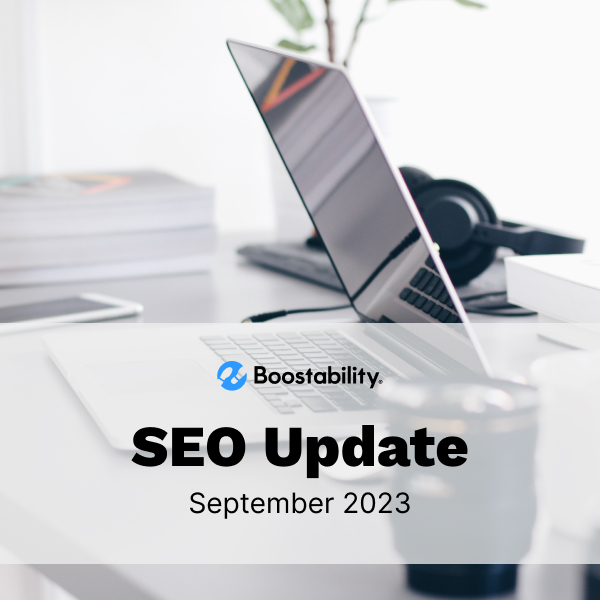
After a few quieter months this summer with not as much SEO news, Google seems to be making up for lost time in the past few weeks with a few updates and newsworthy items. There’s a lot of news out of Google for this month’s update. So buckle up, here we go.
Helpful Content Update
The first “must talk about” update from October is the latest Helpful Content Update. Google said in its release “The September 2023 helpful content update is rolling out with an improved classifier.” It took about two weeks to roll out and takes on content specifically created for search engines, not the end user.
Other details about this update specifically include new guidance about hosting third party content. Plus, how to evaluate and take action on your website after a helpful content system update. It also talked about how to best remove content or change dates on updated content that focuses on the end user instead of the search engine.
With these Helpful Content Updates, Google continues to reward better and more useful content with higher rankings because it’s written to help actual humans instead of just to rank higher. The last Helpful Content Update was in December last year, so it seems that these roll outs will continue to happen.
Google also updated its official Helpful Content page with some new information to avoid creating search engine-first content. These are just a few of their recommendations:
- Ask yourself: “Is this content helpful?”
- Write for humans: Avoid writing for search engines.
- Create content that stands out: Don’t just copy what others are doing.
- Be original: Avoid repackaging existing content.
- Be accurate: Make sure your content is up-to-date and factually accurate.
Google SGE
We want to draw your attention to another bit of news starting to gain more traction in the SEO realm. Google’s SGE, or Search Generative Experience. Jury is still out on how big of an impact it’s going to have, but it will definitely be felt across the search universe. SGE is an experimental feature using AI to generate more informative and comprehensive search results. SGE is currently only available in the United States and can be enabled in Search Labs on Chrome desktop and the Google app.
When you enable SGE, you’ll see AI-powered overviews for some of your search results. These overviews can include summaries of key information, links to additional resources, and even videos and images. SGE can also help you to find answers to your follow-up questions without having to start a new search. For example, if you search for “how to fix a leaky faucet”, SGE could give you step-by-step instructions based on other content around the web. Plus, a video tutorial, and links to relevant products and searches.
Google is still developing SGE, but it has the potential to revolutionize the way we search the web. By using AI to generate more informative and comprehensive search results, SGE can help us to find the information we need more quickly and easily. And in the SEO industry, it could be a game changer in the way we create content, connect our sites through links.
Blocking GPTBot
In last month’s SEO update, we talked about the new GPTBot and how it crawls websites in order to provide answers through ChatGPT. And now with our October update, we have a study from Originality.ai saying that 26% of the top 100 websites in the world are actually blocking GPTBot. That’s up dramatically from the month before when only 69 of the top 1000 websites blocked the crawler.
With that dramatic of an uptick, you might be considering if you need to do the same. Let’s reiterate some of the pros and cons of it. You might want to keep GPTBot from collecting data if you’re concerned about privacy or you don’t want it to scrape your content. Others site concerns about GPTBot being used to generate spam or malicious content like fake news, spam emails, or something else.
But it can be beneficial for those looking to expand the reach of their website, or gain more backlinks because others reference their content. It’s definitely something to consider for anyone with a website! And we included how to block the GPTBot in the August 2023 SEO update if you want to read up on that.
25th Anniversary

Google celebrated its 25th anniversary on September 27, 2023. Which for most of us when we tell our grandkids that we’re older than Google, they’ll likely look at us in disbelief. But they celebrated a quarter century with some fun little items like a special Google Doodle, a blog post highlighting the company’s biggest search breakthroughs over the past 25 years, and a number of other initiatives.
The Google Doodle featured a timeline of the company’s logo, as well as a variety of interactive elements that celebrated Google’s many products and services. The blog post highlighted some of the biggest search breakthroughs over the past 25 years, including:
- The introduction of PageRank, which revolutionized the way search engines worked.
- The launch of Google Search, which quickly became the most popular search engine in the world.
- The development of new search algorithms, such as Hummingbird and BERT, which have made Google Search more accurate and informative than ever before.
- The introduction of new features, such as Knowledge Graph and Local Search, which have made Google Search more useful and accessible to people all over the world.
Google’s Release on Improving Search
Leading up to the 25th anniversary, Google also released a blog talking about 5 ways that they’ve changed our Search experience. Here’s just a few highlights.
1. Delivering quality results
There’s a lot you need to consider when it comes to wanting your content to rank. And it can’t just be about ranking well, good content ultimately comes down to what is helpful and reliable for a user. Citing its PageRank algorithm, Google is pointing out how it’s adapted to the rise of misinformation and how they’ve updated the algorithm to know what is misinformation or bad content designed to spread false information. The post talks through the evolution of the algorithm to provide the best content for each specific query.
For example, information that has changed or evolved. So for example, information about the covid virus at the beginning of 2020 in the early stages of the pandemic are likely outdated compared to research posted today about how the virus has evolved. Also new information on a topic might not have a quality vote of confidence, so Google won’t rank it as highly.
2. Deciphering meaning
The next step, Google talks about how it’s adjusted to better decipher the meaning behind content like how a human would read it. Many words like “change” can have multiple meanings. It can mean how day to day life shifts, or it can mean currency, or it can mean something like an adjustment. The algorithm has morphed from simply matching a word to being able to understand the context behind a query to deliver the best search results. Large language models like BERT have really taken the lead in this realm and have drastically adjusted search results in recent years.
3. Understanding images, videos, and more
Another massive update to Search in general in recent years is that these go beyond text. Images, videos, and context of the full page rather than just specific words and sentences. We can now search by image or text to image results in ways that were unimaginable even a couple years ago. Google says there are over 12 billion visual searches every single month.
This also includes voice search. What was the stuff of science fiction, we can now just ask our Google device, outloud, about our query and it will give an answer. This has drastically changed the way SEO experts do content so that it makes sense not only for someone to read, but for it to be read as well.
4. Spotting and stopping spam
Again, it’s in Google’s best interest to provide the best results possible. And in order to do that, you need to minimize spam. Google says they continually work hard to ensure that spammy content or links don’t make it into your search results. You want to be able to trust that clicking on a link won’t give your computer a virus. Or that the content you read is accurate and not full of bad information designed to lead you astray or sway your opinion. Given the amount of content, it’s hard to know completely if it’s spam free, but Google has taken major strides in penalizing incorrect or spammy content from ranking, and rewarding good content. And AI is playing into this as well to keep results over 99% spam free.
5. Making Search safer
Lastly, this quote from Google sums up nicely what they hope to accomplish in a search result. “Over the years, we’ve maintained a strong commitment to our principles of maximizing access to information, while helping people stay safe and in control. We aim to help people find information that’s within the bounds of legal expression, while not inadvertently exposing them to low-quality or harmful content that they haven’t asked to see.”
In other words, they want to make sure to avoid any unwanted explicit images or content, block sites that use exploitative practices, and allow users to be able to request the removal of personal information shown in search results.
Reading through this, it’s interesting how much our search habits have changed in ways we likely don’t even realize. But shows that Google is ultimately trying to deliver the best search results for each query we type in. It’s in their best interest to continue innovating so we can keep searching.

